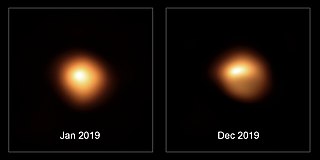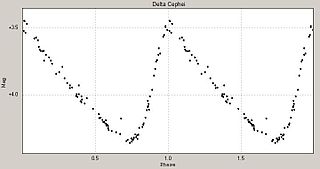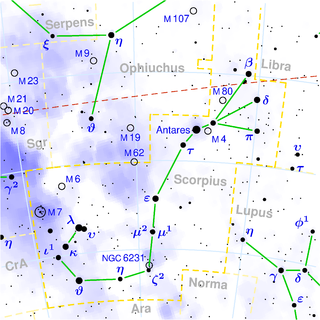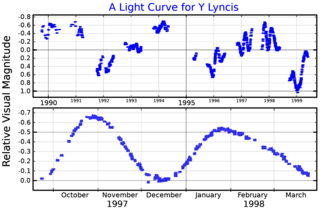
The descriptive term long-period variable star refers to various groups of cool luminous pulsating variable stars. It is frequently abbreviated to LPV.

The descriptive term long-period variable star refers to various groups of cool luminous pulsating variable stars. It is frequently abbreviated to LPV.
The General Catalogue of Variable Stars does not define a long-period variable star type, although it does describe Mira variables as long-period variables. [1] The term was first used in the 19th century, before more precise classifications of variable stars, to refer to a group that were known to vary on timescales typically hundreds of days. [2] By the middle of the 20th century, long period variables were known to be cool giant stars. [3] The relationship of Mira variables, semiregular variables, and other pulsating stars was being investigated and the term long period variable was generally restricted to the coolest pulsating stars, almost all Mira variables. Semiregular variables were considered intermediate between LPVs and Cepheids. [4] [5]
After the publication of the General Catalogue of Variable Stars, both Mira variables and semiregular variables, particularly those of type SRa, were often considered as long period variables. [6] [7] At its broadest, LPVs include Mira, semiregular, slow irregular variables, and OGLE small amplitude red giants (OSARGs), including both giant and supergiant stars. [8] The OSARGs are generally not treated as LPVs, [9] and many authors continue to use the term more restrictively to refer just to Mira and semiregular variables, or solely to Miras. [10] The AAVSO LPV Section covers "Miras, Semiregulars, RV Tau and all your favorite red giants". [11]
The AAVSO LPV Section covers the Mira, SR, and L stars, but also RV Tauri variables, another type of large cool slowly varying star. This includes SRc and Lc stars which are respectively semi-regular and irregular cool supergiants. Recent researches have increasingly focused on the long period variables as only AGB and possibly red giant tip stars. The recently classified OSARGs are by far the most numerous of these stars, comprising a high proportion of red giants. [8]

Long period variables are pulsating cool giant, or supergiant, variable stars with periods from around a hundred days, or just a few days for OSARGs, to more than a thousand days. In some cases, the variations are too poorly defined to identify a period, although it is an open question whether they are truly non-periodic. [8]
LPVs have spectral class F and redwards, but most are spectral class M, S or C. Many of the reddest stars in the sky, such as Y CVn, V Aql, and VX Sgr are LPVs.
Most LPVs, including all Mira variables, are thermally-pulsing asymptotic giant branch stars with luminosities several thousand times the sun. Some semiregular and irregular variables are less luminous giant stars, while others are more luminous supergiants including some of the largest known stars such as VY CMa.
Between a quarter and a half of long period variables show very slow variations with an amplitude up to one magnitude at visual wavelengths, and a period around ten times the primary pulsation period. These are called long secondary periods. The causes of the long secondary periods are unknown. Binary interactions, dust formation, rotation, or non-radial oscillations have all been proposed as causes, but all have problems explaining the observations. [12]
Mira variables are mostly fundamental mode pulsators, while the semiregular and irregular variables on the asymptotic giant branch pulsate in the first, second, or third overtone. Many of the less regular LPVs pulsate in more than one mode. [13]
Long secondary periods cannot be caused by fundamental mode radial pulsations or their harmonics, but strange mode pulsations are one possible explanation. [12]

A variable star is a star whose brightness as seen from Earth changes with time. This variation may be caused by a change in emitted light or by something partly blocking the light, so variable stars are classified as either:

In astronomy, a semiregular variable star, a type of variable star, is a giant or supergiant of intermediate and late (cooler) spectral type showing considerable periodicity in its light changes, accompanied or sometimes interrupted by various irregularities. Periods lie in the range from 20 to more than 2000 days, while the shapes of the light curves may be rather different and variable with each cycle. The amplitudes may be from several hundredths to several magnitudes.

Red supergiants (RSGs) are stars with a supergiant luminosity class of spectral type K or M. They are the largest stars in the universe in terms of volume, although they are not the most massive or luminous. Betelgeuse and Antares A are the brightest and best known red supergiants (RSGs), indeed the only first magnitude red supergiant stars.

Mira variables are a class of pulsating stars characterized by very red colours, pulsation periods longer than 100 days, and amplitudes greater than one magnitude in infrared and 2.5 magnitude at visual wavelengths. They are red giants in the very late stages of stellar evolution, on the asymptotic giant branch (AGB), that will expel their outer envelopes as planetary nebulae and become white dwarfs within a few million years.

The red-giant branch (RGB), sometimes called the first giant branch, is the portion of the giant branch before helium ignition occurs in the course of stellar evolution. It is a stage that follows the main sequence for low- to intermediate-mass stars. Red-giant-branch stars have an inert helium core surrounded by a shell of hydrogen fusing via the CNO cycle. They are K- and M-class stars much larger and more luminous than main-sequence stars of the same temperature.

A Delta Scuti variable is a subclass of young pulsating star. These variables as well as classical cepheids are important standard candles and have been used to establish the distance to the Large Magellanic Cloud, globular clusters, open clusters, and the Galactic Center. The variables follow a period-luminosity relation in certain passbands like other standard candles such as Cepheids. SX Phoenicis variables are generally considered to be a subclass of Delta Scuti variables that contain old stars, and can be found in globular clusters. SX Phe variables also follow a period-luminosity relation. One last sub-class are the pre-main sequence (PMS) Delta Scuti variables.

RV Tauri variables are luminous variable stars that have distinctive light variations with alternating deep and shallow minima.
Alpha Cygni variables are variable stars which exhibit non-radial pulsations, meaning that some portions of the stellar surface are contracting at the same time other parts expand. They are supergiant stars of spectral types B or A. Variations in brightness on the order of 0.1 magnitudes are associated with the pulsations, which often seem irregular, due to beating of multiple pulsation periods. The pulsations typically have periods of several days to several weeks.

119 Tauri is a red supergiant star in the constellation Taurus. It is a semiregular variable and its angular diameter has been measured at about 10 mas.

W Cephei is a spectroscopic binary and variable star located in the constellation Cepheus. It is thought to be a member of the Cep OB1 stellar association at about 8,000 light years. The supergiant primary star is one of the largest known stars and as well as one of the most luminous red supergiants.

S Persei is a red supergiant or hypergiant located near the Double Cluster in Perseus, north of the cluster NGC 869. It is a member of the Perseus OB1 association and one of the largest known stars. If placed in the Solar System, its photosphere would engulf the orbit of Jupiter. It is also a semiregular variable, a star whose variations are less regular than those of Mira variables.

RV Andromedae is a variable star in the constellation of Andromeda. It is classified as a semiregular variable pulsating giant star, and varies from an apparent visual magnitude of 11.5 at minimum brightness to a magnitude of 9.0 at maximum brightness, with a period of approximately 168.9 days.
VX Sagittarii is an extreme asymptotic giant branch star located more than 1.5 kiloparsec away from the Sun in the constellation of Sagittarius. It is a pulsating variable star with an unusually large magnitude range. It is also one of the largest stars discovered so far, with a radius varying between 1,350 and 1,940 solar radii (940,000,000 and 1.35×109 km; 6.3 and 9.0 au). It is the most luminous known AGB star, at bolometric magnitude –8.6, which is even brighter than the theoretical limit at –8.0.

Stellar pulsations are caused by expansions and contractions in the outer layers as a star seeks to maintain equilibrium. These fluctuations in stellar radius cause corresponding changes in the luminosity of the star. Astronomers are able to deduce this mechanism by measuring the spectrum and observing the Doppler effect. Many intrinsic variable stars that pulsate with large amplitudes, such as the classical Cepheids, RR Lyrae stars and large-amplitude Delta Scuti stars show regular light curves.

Classical Cepheids are a type of Cepheid variable star. They are young, population I variable stars that exhibit regular radial pulsations with periods of a few days to a few weeks and visual amplitudes ranging from a few tenths of a magnitude up to about 2 magnitudes. Classical Cepheids are also known as Population I Cepheids, Type I Cepheids, and Delta Cepheid variables.

AH Scorpii is a red supergiant variable star located in the constellation Scorpius. It is one of the largest stars known by radius and is also one of the most luminous red supergiant stars in the Milky Way.

T Persei is a red supergiant located in the constellation Perseus. It varies in brightness between magnitudes 8.3 and 9.7 and is considered to be a member of the Double Cluster.

Y Lyncis is a semiregular variable star in the constellation Lynx. It is an asymptotic giant branch star of spectral type M6S, with a luminosity class of Ib, indicating a supergiant luminosity. It is around 1,160 light years away.

BC Cygni is a red supergiant and pulsating variable star of spectral type M3.5Ia in the constellation Cygnus.

HV 888, also known as WOH S140, is a red supergiant (RSG) star located in the Large Magellanic Cloud. It is among the largest known stars, with estimates of its radius ranging from 765 R☉ to over 1,700 R☉, and is also one of the most luminous of its type with a range of nearly 300,000 to over 500,000 times that of the Sun (L☉). The effective temperature is estimated to be around 3,500 K. If placed at the center of the Solar System, its photosphere would engulf the orbit of Jupiter and possibly even Saturn.